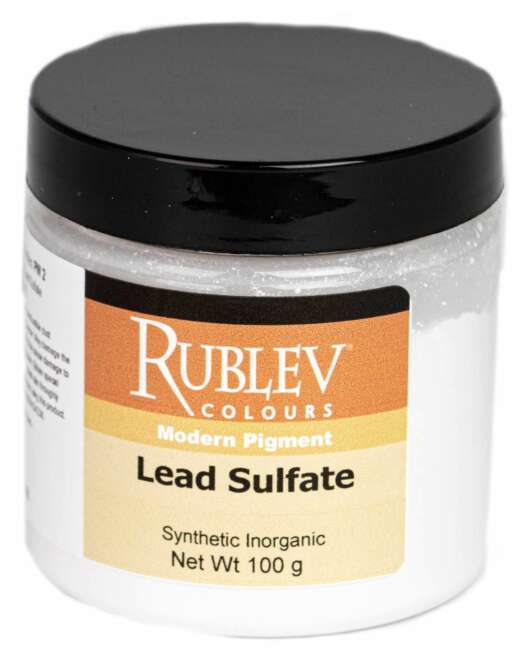
The term 'flake white' originated from the fact that when basic lead carbonate is made according to the old Dutch method or 'stack process,' it falls off the metallic pieces of lead as flakes. This is not the case when lead white is made according to modern processes, which is the pigment type used by all artists' paint manufacturers today. (See note below.)
The term 'flake white' used by most artists' materials manufacturers today for their white oil paint designates a paint made by grinding bare lead carbonate ground in a vegetable drying oil (linseed, walnut, or safflower oil) with a small amount of zinc oxide.
The term 'Cremnitz white' erroneously originated from the designation of basic lead carbonate manufactured in Klangenfurt, Austria, in the eighteenth and nineteenth centuries according to a process similar but not identical to the 'stack process.' The lead used in manufacturing lead white in Klangenfurt came from galena mines in the vicinity of Krems (in the state of Carinthia, Austria), hence the names Kremsweiss, Kremserweiss, Krems White, Kremser White, and the erroneous attributions Cremnitz White or Kremnitz White. This is noted by the report of the Consulate General of the United States, Edmund Jussen, in Vienna in 1887:
Kremserweiss (Kremser white)... bears this name because, at some remote period, an excellent quality of white lead was manufactured at Krems, a small and ancient city in Lower Austria. At present, no white lead is manufactured at Krems, and dealers here assert that for at least one hundred and fifty years no white lead has been produced at Krems. The industry of the city has for a long time been confined to the manufacture of hardware, mustard, and vinegar; but the best quality of white lead still bears the name of "Kremserweiss."
"Cremnitz" weiss, or white, is an appellation unknown to the trade here, and doubtless originated in the similarity of the two names of Krems and Cremnitz (or Kremnitz). Kremnitz (or Cremnitz) is a small city (population, 8,550) in the Bars Comitat in Hungary, and I am informed by Austrian dealers that no white lead whatever is manufactured there. ...white lead has never been manufactured at Kremnitz in any quantity whatever. Mr. Henry Sterne, United States consul at Budapest, informs me further that the Hungarian dealers in white lead state that no white lead is manufactured at Kremnitz, and that Kremserweiss, but not Kremnitzerweiss, is known in the Hungarian market."
The term 'Cremnitz white,' used by most artists' materials manufacturers today for their white oil paint, is for a paint made by grinding basic lead carbonate ground in a vegetable drying oil (linseed, walnut, or safflower oil) without the addition of zinc oxide.
Reference
Edmund Jussen, "White Lead Industry of Austria," Reports from the consuls of the United States, Issues 81-84, United States. Bureau of Foreign Commerce, General Printing Office, 1887, p. 413.
Note
Natural Pigments is one of the only artist materials manufacturers in the world to produce genuine 'stack process' lead white (or 'flake white') in the Rublev Colours brand of pigments and oil paints.
Resources
For more information on how Natural Pigments makes stack process flake white, how it was made throughout history, and how it differs from modern lead white, please read Stack Process White Lead: Historical Method of Manufacture. Another article, Notes About Stack Process Lead White, discusses differences between modern lead white and our production of stack process flake white pigment. A third article, Variations of Stack Flake White, examines the properties of larger particle size stack process flake white in oil paint.
For a complete description of white pigments used in artists' paints, please read the article White Pigments.








